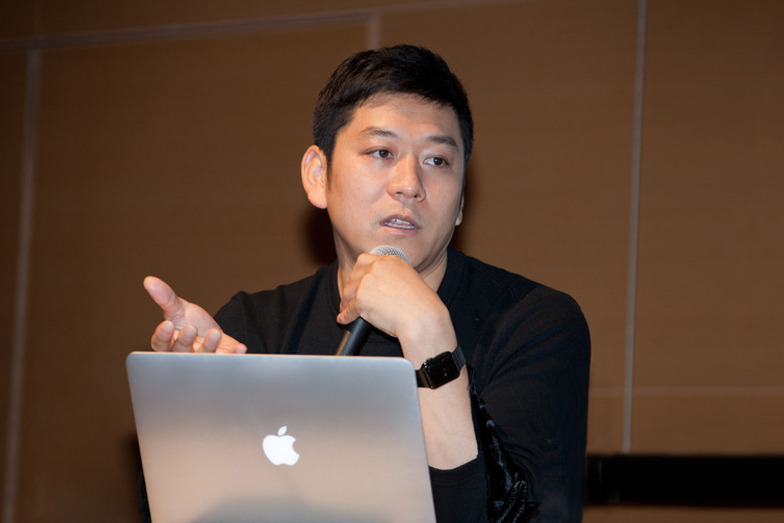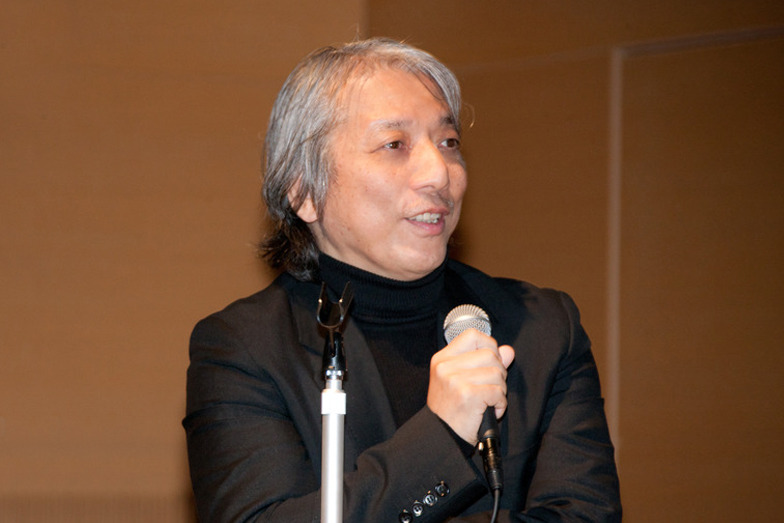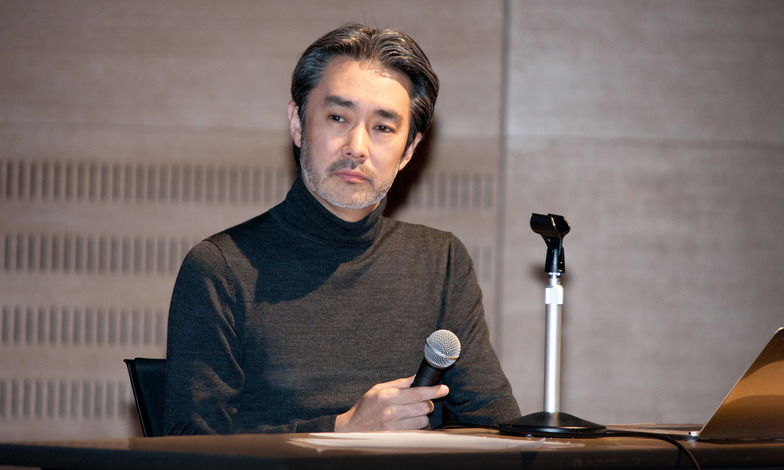Sculptor Kohei Nawa has expanded his creative domain beyond sculpture to include developing materials with diverse textures, engineering with new technologies like 3D printing, directing spatial designs such as architecture, and creating individual artworks. In recent years, a new form of collaboration between business and art, known as "commission work," has begun emerging in Japan, and Nawa is active in this field as well. Historically, art has constantly clashed with business, occasionally collaborating, mutually stimulating and influencing each other. This time, we discuss the future of art collaboration with three individuals: editor Shigeo Goto, who produces commissioned work; and Mitsufumi Abe of Dentsu Inc., who planned an art project with Nawa for Yaskawa Electric's 100th anniversary. This is the second part of that discussion.

(From left) Mr. Abe, Mr. Nawa, Mr. Goto
Artists propose
Proposed by an Artist
Goto: While Nawa-kun develops art and applies it to architecture and design, he also actively engages in presentations for the Olympics and urban planning. The Olympics are both a festival of sports and a festival of culture. They become a platform to foreshadow and broadcast globally the vision and mission Japan will present, utilizing the power of art and artists.
Nawa: "Tokyo Caravan" is a Tokyo Metropolitan Government project—a leading initiative for the Olympics I'm working on with Hideki Noda and Katsuhiko Hibino. Last year, we held a workshop at Komazawa Park inviting around 1,000 guests. Based on the idea of creating a time where performers and audience could exist on equal footing, we designed a venue where guests could see backstage areas, placing a sculpture right in the center.
The "Tokyo Festival City Concept," conceived with Arata Isozaki and Kazuyo Sejima, reimagines the capital's public squares. It proposes holding a monumental festival at the Imperial Palace Plaza during the 2020 Olympics, one grand enough to renew the history of human celebration, thereby declaring a new "Tokyo" to the world.
For the Festival City Concept, I proposed "Space Fireworks." It's a plan to drop metal spheres from outside the stratosphere. The spheres would fall while burning, and the flame colors would make them look like fireworks. They might be visible not only from the stadium but from all over Japan.

There is a work by Anne Hamilton that I really like, so let me introduce it. It is an installation made only of wire and fabric, without using any technology. A huge piece of fabric is hung like a wall in the middle of a large space and connected to countless wires. When people touch the fabric, the wires are pulled and the shape of the fabric changes. I think this is a message for our times. In this global era, everyone is loosely connected, and messages are reflected in a vague way. But there are still murky walls. I think this kind of new public space is needed in this day and age. I believe it can be created without using cutting-edge technology, but rather by utilizing old places and traditional expressions.
Abe: The sheer volume of creations and ideas is overwhelming... How do you distinguish commissioned work from your own creative activities, Mr. Nawa?
Nawa: I always have many things I want to make and ideas, but I'm in a situation where I can't fully realize them all. So with commissioned work, rather than starting from scratch to answer the given prompt, I often think about which of my ideas might fit the concept.
Connecting dynamically with the times
is the greatest appeal of contemporary art
Goto: I think many people in the audience have realized by now that Nawa-kun is different from previous artists. Both companies and artists are changing now. So, my job is to produce happy encounters between those who are changing.
Abe: From your perspective, Goto-san, do you think demand for art is increasing in Japanese society?
Goto: I believe a recognition is emerging that art "enhances a company's social value." Especially for global corporations like Yaskawa Electric, there's a need to visualize and present statements to customers worldwide. In this kind of non-verbal communication, art is incredibly powerful. It's not just about having cool art; as Nawa-kun mentioned, it's crucial to recognize art as something that invites participation, expands concepts like life and connection, and brings new ideas to the company.

Nawa: Contemporary art is a living thing. Being in the same air right now is what makes it contemporary. Things happening in the world, or those fleeting sensations you get walking through a city, blossom within art. The most thrilling and interesting aspect of contemporary art is its dynamic engagement with the times. You can actually meet the artist, and even create together. Art isn't limited to what's in museums. The seeds of art exist within people, and it's about how those seeds bear fruit. I think the artists who understand this are the ones thriving now.
Abe: Advertising is also one of the many links companies have with the world. I feel that companies will increasingly express their ideas and sense of contemporaneity, beyond just products, through artists.
Goto: Lately, companies sometimes ask us, "We want an artist to do the design, not a graphic designer." To put it bluntly, designers are seen as "surface creators," while there's a growing expectation for the depth of an artist's thinking. I hope companies will fall in love with an artist's values, become patrons beyond just commission work, and collaborate in various ways... supporting the artist's activities for the long term.
Nawa: This applies to designers and architects alike—work driven by client expectations tends to develop a habit of soft-landing, ensuring no issues with expression. Architects often seek collaborations with artists precisely because artists disregard clients and architectural rules, demanding their own vision. That's the beauty of it. Rules get shattered instantly, sparking a leap in expression and creating opportunities for architects to try things they've always wanted to do but couldn't. The relationship between Kenzo Tange and Taro Okamoto, who created the Tower of the Sun for the Osaka Expo pavilion, is a perfect example. That's the most fascinating aspect of collaborating with artists.
Goto: I always tell clients who want to work with artists, "Art is like the sun—it's warm when you're far away, but get too close and you'll get burned to a crisp" (laughs). Once companies understand that, they can effectively harness an artist's energy.
Nawa: Artists intuitively sense the expression of their era, and that holds authenticity. I want corporate people to see that. If you keep doing commercial work, you get into the habit of making design compromises to meet client demands. That's dangerous for artists. Occasionally, you find someone living in the present whose deep-seated authenticity just oozes out. It's crucial to let such people properly leave something behind that captures their era.
Goto: Experiencing performative art, like the drone aerial sculpture we discussed earlier, becomes a new medium for artists itself. I hope companies will create many such opportunities without thinking contemporary art is difficult or expensive.
Nawa: I don't consider the Yaskawa Electric project finished yet. Simply creating a sculpture for the entrance would make it just another ordinary job. I want to think about the next project, like creating work using Yaskawa's robotic arms.
Abe: Beyond Yaskawa Electric, I believe opportunities for companies to collaborate with artists will continue to expand. We will keep challenging ourselves with such projects.
You can also read this interview on Ad-T!
Planning & Production: Aki Kanahara, Dentsu Inc. Event & Space Design Bureau








